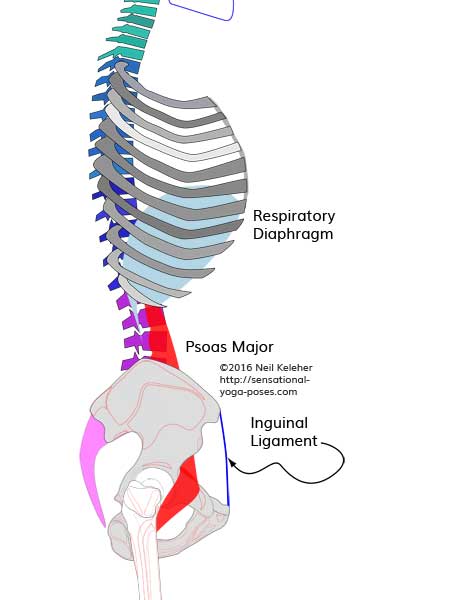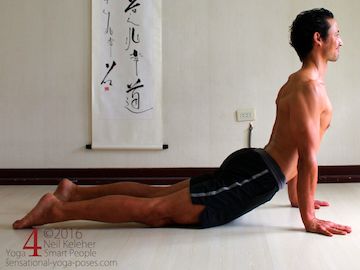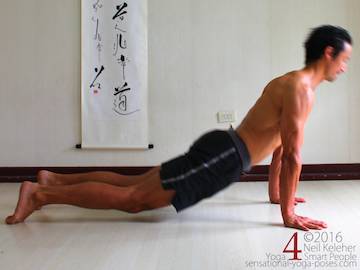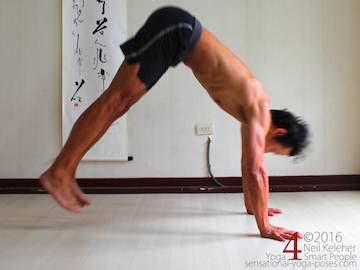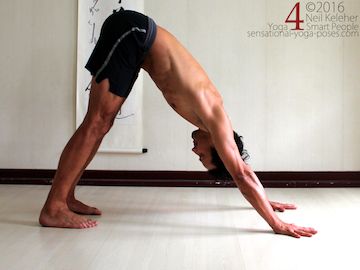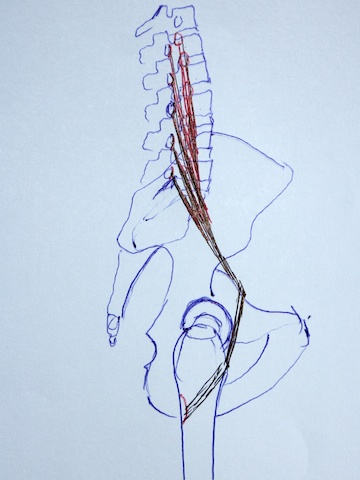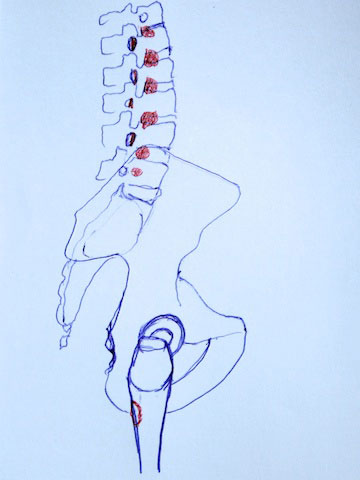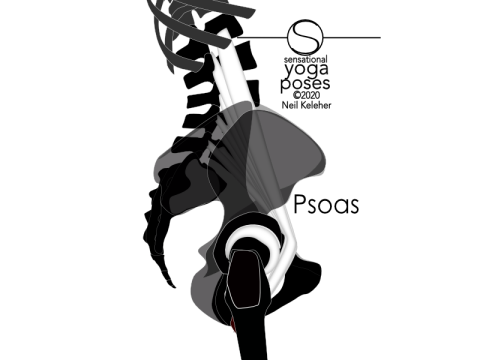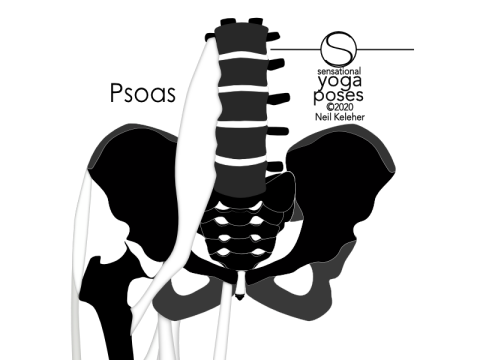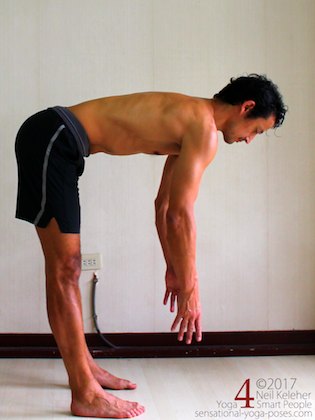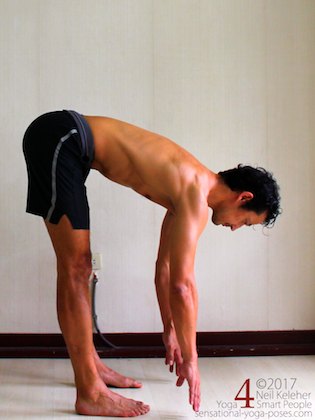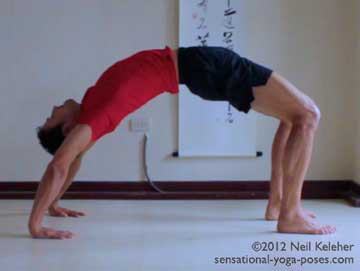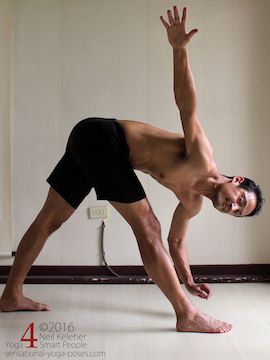Using the Psoas Muscle to Transition from Upward Dog to Downward Dog
With knees kept straight you can fling your pelvis up from upward dog by kicking the floor with your feet. In most kicks you start to swing the leg and then it makes contact. In this case, your feet are already in contact with the floor but the feeling in the legs is like you are kicking the floor.
Try a "slight" kick first. Notice any discomfort in your lumbar spine? Engage your abs to stabilize your lumbar spine so that you lumbar spine stays comfortable. Then work at gradually increasing the strength of your kick until the point that your kick launches your pelvis high enough that your feet leave the floor.
Note that when you are working towards this, when you sink back down into upward dog (because your kick wasn't strong enough) I'd suggest controlling your descent so that you don't "bounce" at the body of upward dog.
When you do jump high enough that your feet come off of the floor, flick your toes forwards so that you land on the soles of your feet in downward dog.
Also note that you'll probably land in a "short" downward dog. To land in a longer downward dog use your shoulders to push your body back while you are in mid air.
Is the Psoas Muscle a Lumbar Spine Flexor
or Lumbar Spine Extensor?
Because the psoas attaches to each of the five lumbar vertebrae and also to the lowest thoracic vertebrae, there tends to be some argument as to whether it flexes or extends the lumbar spine.
Movement terms for the psoas?
It may be more worthwhile either to come up with new movement terms for the effect the psoas muscle has on the spine (lumbar stabilizer?) or divide the psoas into two, three, five or six sections, each with a particular affect on the lumbar vertebrae (and thoracic vertebrae) it attaches to.
In terms of deliberately activating the psoas muscle or stretching it, it may be best to think of the lumbar spine as either extended or flexed, use the abs and erector spinae to maintain the bend of the lumbar spine so that the lumbar spine and pelvis can then be modeled as one integrated unit. (Read Psoas Major 2 for more on this.) Then you can focus on using the psoas (along with iliacus) to tilt the pelvis and body forwards as one unit or to resist the pelvis and body being tilted backwards.
The Upper and Lower Psoas Muscle
In terms of stretching the psoas muscle it can be useful to think of the psoas in two parts, the upper psoas muscle and the lower. The upper fibers may be the easiest to stretch. The lowest fibers the most difficult. And it's the lower fibers which may be responsible for low back pain in some people.
The lower attachment point of both the upper and lower psoas is to the back of the inner thigh at the lesser trochanter. This attachment point is just below the neck of the femur and located near the back of the inner edge of the femur.
Stretching the Lower and Upper Fibers of the Psoas
To stretch both the lower and upper fibers of the psoas you can try this Standing Psoas Stretch.
The Psoas Muscle as a Lumbar Stabilizer
The abdominals act across the front of the lumbar (and thoracic) spine and can be used (in opposition) to the erectors to bend the lumbar spine forwards or fix the spine in place (in this case ab tension and spinal erector tension are approximately equal.) The abdominals (apart from the transverse abdominus) do not act directly on the inter lumbar vertebral joints. They act on the lumbar spine indirectly by pulling mainly on the ribs and the pelvis.
The psoas muscle is the only muscle (apart from the respiratory diaphragm) with fascicles that directly attach to the bodies of the lumbar vertebrae.
Rather than flexing or bending the lumbar spine these fascicles may act to support the lumbar spine in opposition (or cooperation) with the spinal erectors and paraspinalis muscles that act on the back of the spine. They may act to fine tune the tension on each lumbar joint so that the pressure on each disc, from front to back, is equalized, or at least brought within a tolerable range for the discs.
(Read about tensegrity for more on using tension to integrate the body.)
Stability in different positions
For the psoas to be able to act as a stabilizer and exert this equalizing force, first of all it needs to be able to lengthen and activate depending on the position that the body is in.
In a vertical upright standing position, the psoas muscle may not need to be active at all in order to support the lumbar spine. It's in a stretched position and the stretch in its fibers may cause enough of a stabilizing force. However, when bending forwards at the hips so that the torso is horizontal and at 90 degrees to the legs, the situation is different. This is especially the case when the arms aren't being used to support the weight of the upper body.
So that the lumbar erectors don't excessively squeeze the backs of the lumbar discs (and bulge the fronts of the discs) it may be appropriate to bend the lumbar spine forwards slightly so that it's curvature flattens. This can help to decompress the backs of the discs but also as described above may bring the lumbars away from the pubic bone giving the psoas room to activate. It can then exert the necessary frontal compression on the lumbar discs to balance the back compression of the spinal erectors.
If the psoas isn't activated, then other muscles may come into play to compensate.
When active, the psoas may add tension to the lumbar segment of the ligament that runs down the front of the vertebral bodies. Tension in this ligament could help to resist forward bulging of the lumbar discs. Additionally, since the psoas attaches to the sides of the lumbar discs, activation of the psoas may add enough tension to the sides of the discs that bulging is resisted there also.
Giving the Psoas Muscle Room in Standing Forward Bend
One way to experience this is to stand upright and first focus first on lengthening the psoas by drawing the lumbars away from the pubic bone so that the lumbar spine flattens (focus on drawing it away from the two inguinal ligaments). Make the lower back feel "full" or open.
Then slowly bend forwards while keeping that feeling.
Moving slowly is important because you can stop yourself if you notice that it doesn't feel right.
And so that the spinal erectors aren't overworked, nor the hamstrings for that matter, you may find it helpful to squeeze your butt cheeks (gluteus maximus) as you bend forwards. Use your butt cheeks to help support and control the forward tilt of your hip bones.
(In this case the glutes and psoas muscle may also be working against each other to stabilize and control the hip joint. The psoas acts to push the pelvis back while pulling forwards on the lumbar spine and thighs. The gluteus maximus acts to push the pelvis forwards while pulling back on the thighs.)
Using the Psoas In Wheel Pose
A similiar rational could be applied to how the psoas could work in wheel pose.
In wheel pose the spine is almost horizontal and arched backwards with the arms and legs exerting leverage on the pelvis and ribcage. Activating the psoas in this posture may provide the lumbar spine with enough stability that it actually enables you to go deeper into the pose or at least stay in the pose more comfortably.
How do you activate the psoas muscle in wheel pose? If you practice pulling the lumbars away from the inguinal ligaments while standing you can use a similar visualization in wheel pose. However in wheel pose you might choose to focus on pulling the lumbars forwards or upwards.
To make it easier to feel your lumbars spend some time in bridge pose before going up into wheel pose. And rather than thrusting your self up, press up smoothly into the pose so that you can feel your body while you do so.
Strengthening the Psoas, Stretching it or Controlling It
So if the psoas is engaged in the standing forward bend are you strengthening it by using it? And if it is engaged in wheel pose are you stretching it (while it is active?) I'd suggest that in both cases you are controlling it or at the very least varying the tension within that muscle so that your body functions better as an integrated whole.
The Psoas and Lumbar Rotation
One other offshoot I'll mention is using the psoas in spinal twists.
If you are doing a standing twist to the right, you can use the psoas to pull forwards on the left side of each of the lumbar vertebrae. Prior to this, activate gluteus maximus on the left side. This is to stabilize the hip joint and also give the psoas a firm foundation from which to work from. For a fuller twist you can focus on each vertebrae in turn working from the lowest lumbar vertebrae all the way up to the base of your skull. When turning your thoracic vertebrae, first focus on the individual vertebrae, then focus on the ribs, turning vertebrae and ribs relative to each other.
I like to stand with feet about hip width or shoulder width apart when doing this twist. I also stand with my feet parallel and try to keep the weight even on both feet. Also stay aware of your pelvis. You can do the twist and allow your pelvis to twist or keep your pelvis square to the front.
Repeat a few times to each side, going slowly. Then see if you can duplicate the feeling in a pose like revolved (twisted) triangle.
More on the Psoas
For the latest on the psoas, particularly on what can cause it to "fall back against the spine" read Understanding the psoas.
For more on countering the shearing action of the lower fibers of the psoas muscle in poses like reclining hero read psoas major 2.
For more on using the psoas in poses like forward bends and jumping up into handstand read psoas major.
For a detailed description of how I learned about the connection between the psoas, the kidneys and the diaphragm (thanks Richard Freeman and Tom Myers) read psoas major 1.
And for stretching while using the external obliques to stablize the lumbar spine you can read psoas stretches 1. For psoas muscle stretches that using lumbar spine awareness read Psoas Stretches.
To learn more about different fascial connections or connective tissue connection within the body read about anatomy trains, a set of myofascial meridians described and talked about by Tom Myers.
Published: 2011 12 13
Updated: 2020 01 15
